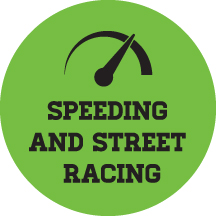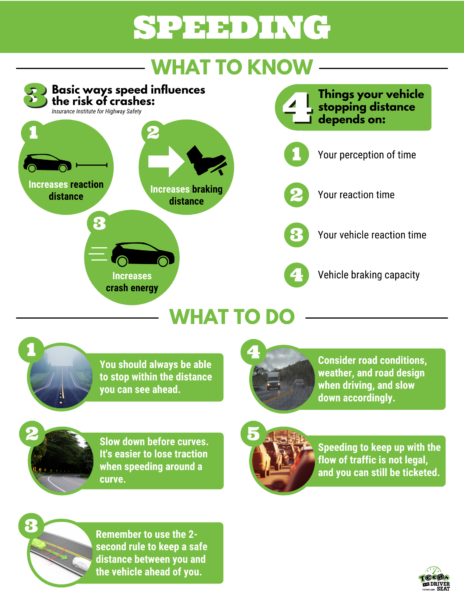 Teens do not consider driving 5 to 10 miles above the speed limit to be dangerous
Teens do not consider driving 5 to 10 miles above the speed limit to be dangerous
The problem of speeding:
- In a high-speed crash, a passenger vehicle cannot withstand the force of the crash which can easily crush a vehicle. As crash speeds get very high, restraint systems such as airbags and seat belts may not be enough to protect your life.1
- In 2022, about 29% of all traffic fatalities involved at least one driver who was speeding.2
- According to 2022 crash data, male drivers were represented in speed-related fatal crashes at a rate of 5x the number of female drivers for all age groups.2
Speed influences the risk of crashes and crash injuries in three basic ways:1
-
- It increases the distance a vehicle travels from the time a driver detects an emergency to the time the driver reacts, so by the time you realize you need to react, you’ve traveled closer to the danger.
- It increases the braking distance. For example, if you double your speed – say from 30 mph to 60 mph – your braking distance does not become twice as long. It becomes four times as far. Traveling at 55 mph, it will take about 6 seconds to stop your vehicle. The vehicle will travel approximately 302 feet before coming to a stop. That is longer than the length of a football field3.
- It increases the crash energy by the square of the speeds. For example, when impact speed increases from 40 to 60 mph (a 50 percent increase), the energy that needs to be managed increases by 125 percent.
The total stopping distance of your vehicle depends on four things:3
-
- Your perception time
- Your reaction time
- Your vehicle reaction time
- Your vehicle braking capability
- Teens are more likely than older drivers to speed and allow shorter headways (the distance from the front of one vehicle to the front of the next).4
- Speeding has been found to be more prevalent among teenagers who reported more risky friends, particularly among those who reported lower perceived risk for risky driving.5
- Teens with exclusive access to a vehicle were more likely to speed than those who shared a vehicle and more likely to speed at night and with passengers.6
What to do about speeding:
- Know with every mile per hour increase you also increase your reaction travel time, braking distance, and crash energy.1
- High-speed wrecks compromise your car’s safety features.1
- When you speed, you also decrease the judgment of other drivers to be able to gauge your distance and speed.
- Understand speed limits are set with safety in mind. They are based on the roadside environment, roadway design, and pedestrian traffic.1
- Speeding to keep up with the flow of traffic is not legal and you can still be ticketed.
- Speeding decreases your fuel efficiency.
- You should always be able to stop within the distance you can see ahead.
- Consider road conditions, weather, and road design and slow down accordingly.
- It is easier to lose traction when speeding around a curve and the high center of gravity makes it easier to roll over. Slow down before curves.
- Remember to use the two-second rule to keep a safe distance between you and the car ahead of you.
Sources:
- Insurance Institute for Highway Safety: https://www.iihs.org/topics/speed
- NHTSA FARS Data, 2022
- Ritzel, Dale O. (2003). Stopping a vehicle, Southern Illinois University. Retrieved from https://ritzel.siu.edu/courses/302s/vehicle/totalstoppingdistance.htm
- CDC, https://www.cdc.gov/transportationsafety/teen_drivers/teendrivers_factsheet.html
- Simons-Morton, B. G., Ouimet, M. C., Chen, R., Klauer, S. G., Lee, S. E., Wang, J., & Dingus, T. A. (2012). Peer Influence Predicts Speeding Prevalence Among Teenage Drivers. Journal of Safety Research, 43(5-6), 397–403.http://doi.org/10.1016/j.jsr.2012.10.002
- Klauer, B.G. Simons-Morton, S.E. Lee, M.C. Ouimet, E.H. Howard & T.A. Dingus (2011). Novice drivers’ exposure to known risk factors during the first 18 months of licensure: The effect of vehicle ownership. Traffic Injury Prevention, 12 (2), pp.159-168.
Updated: August 2023
